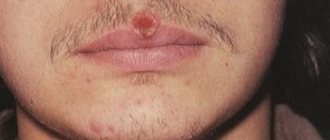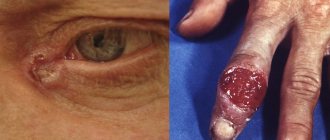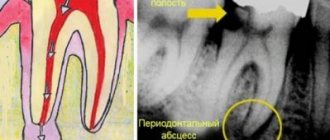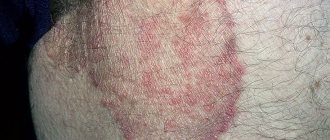Donovanosis (granuloma inguinale, granuloma venereum) is a classic, chronic sexually transmitted disease. It is caused by the bacterium Klebsiella granulomatis (formerly called Calymmatobacterium granulomatis). It is found endemically in underdeveloped countries in tropical and subtropical regions. In the United States, blacks are seven times more likely to be infected than whites. People living in poor socio-economic conditions are most often affected.
Klebsiella granulomatis is a gram-negative bacterium belonging to the family Enterobacteriaceae. Penetrating through the skin, it causes an inflammatory reaction that can lead to the destruction of infected tissue. As part of the inflammatory focus, bacteria are localized inside tissue macrophage cells (Donovan bodies). Donovan Taurus is named after Charles Donovan. He was the first to discover them.
The bacteria are an integral part of the physiological intestinal flora and can very easily be transmitted to the genital area through autoinoculation or sexual intercourse.
The first known name for this condition was "serpiginous ulcer", dating back to 1882. The correct clinical term used today for donovanosis is granuloma inguinale. Granuloma is a type of inflammatory reaction that occurs as a result of injury or infection.
Incubation and symptoms of donovanosis
The content of the article
The incubation period - the time from infection to the appearance of the first symptoms - is long and lasts from 10 to 40 days. It manifests itself by the appearance of small painless nodules in the area of the external genitalia (vulva, penis).
Subsequently, the skin over the change ruptures and ulceration of the granulomatous bottom occurs. It spreads by autoinoculation and affects the perineal area, anal area and groin. The ulcers are usually painless and relatively clean. Inguinal lymphadenopathy, an enlargement of the inguinal lymph nodes, is also often present.
Syphilis is treated and not treated
Systematic treatment of syphilis currently gives good results, especially when it is started soon after the first signs of the disease appear. Timely and vigorous treatment of syphilis in the mother during pregnancy is the best way to prevent syphilis in the child. But advanced stages of the disease are incurable.
Treatment of syphilis, as well as gonorrhea, should only be carried out by a doctor. It must be remembered that a cure can be achieved only on the condition that the patient accurately follows every doctor’s prescription and carefully carries out the entire course of treatment.
ONLINE REGISTRATION at the DIANA clinic
You can sign up by calling the toll-free phone number 8-800-707-15-60 or filling out the contact form. In this case, we will contact you ourselves.
Treatment of donovanosis
Antibiotic treatment is very effective. This is why the incidence of this classic sexually transmitted disease is very low in developed countries (about a hundred cases per year are reported in the United States), in contrast to underdeveloped regions where the availability of antibiotics is limited.
Treatment is usually with the following antibiotics:
- sulfamethoxazole trimethoprim (Sinersul) orally for 14 days;
- doxycycline (vibramycin, chiramycin) per os for 14 days;
- azithromycin (Sumamed) orally for 7 days;
Although improvements in the condition appear after the first week of taking antibiotics, treatment should be completed completely to reduce the number of relapses.
Effective preventive measures include:
- avoiding sexual contact with people at risk, especially in endemic areas;
- preventive testing for sexually transmitted diseases.
Treatment
It should be noted: in advanced cases, when it is not possible to get rid of chancre, as well as with extensive tissue necrosis, they resort to surgical removal of syphiloma.
In all other cases, the chancre itself is not treated and specific treatment for uncomplicated chancre is not carried out. For secondary and combined infections, topical antibacterial drugs may be prescribed: baths with benzylpenicillin and dimexide, applications with mercury or mercury-bismuth ointment. If the chancre is located in the oral cavity, rinsing is recommended: a solution of furatsilin, boric acid (2%), or gramicidin (2%).
The main task is to get rid of syphilis as quickly as possible and with minimal losses. Therefore, to treat syphilis, penicillin antibiotics are used - short and long-acting (durant) penicillins: Bicillin-1, Bicillin-5, Oxacillin, Ampicillin (semi-synthetic penicillin). The drug of choice for the treatment of syphilis is benzylpenicillin.
Reserve drugs for penicillin intolerance: tetracyclines (doxycycline), macrolides (azithromycin, erythromycin), cephalosporins (ceftriaxone).
Administration of drugs is by injection - intravenous or intramuscular.
Source: CC0 Public Domain
The treatment regimen depends on the stage of the disease, location, degree of damage, etc. In any case, the dose of the drug and the number of courses of treatment are calculated by the doctor individually.
During treatment, control tests are carried out to confirm the effectiveness of the drugs.
Treatment of syphilis at an early stage is the most effective and creates all the prerequisites for a complete cure without consequences and complications.
Recommendations for the treatment period
During the treatment period, it is necessary to stop sexual intercourse. When chancre is localized on the fingers, it is recommended to wear protective gloves. If syphiloma is found in the mouth, it is necessary to separate personal items from common ones - dishes, toothbrushes, etc.
If there are chancres on the body, the use of bed linen, towels, and washcloths should be individual. Syphilis is not transmitted through public places (toilet, etc.).
Sexual partners of sick people receive preventive treatment without fail, including pregnant and lactating women.
Important! You should definitely complete the full course of treatment! Under no circumstances will syphilis go away spontaneously. Untreated syphilis will move to the next stage, increasing the risk of complications and persistent deterioration of the patient’s condition.
Clinical serological control (CSC)
All family members of the sick person, both adults and children, need to receive preventive treatment after sexual or close household contact with patients with early forms of syphilis. 3 months after the end of preventive treatment, a single clinical and serological examination is carried out.
Clinical serological control (CSC) after the end of specific treatment of the patient is carried out once every 3 months during the first year of observation. Then once every 6 months in subsequent years with non-treponemal (simple serological) tests, once a year with the corresponding treponemal test (a complex test to identify possible latent forms of syphilis), which was used in diagnosing the disease. The duration of CSC is determined individually depending on the results of treatment.
Children born to seropositive mothers who did not have congenital syphilis, regardless of whether they received preventive treatment or not, are subject to observation for 1 year. Children receiving specific treatment are on CSC for 3 years.
Ulcus molle (chancroid, soft chancroid)
Ulcus molle is a classic sexually transmitted disease caused by the bacterium Haemophilus ducreyi. Usually found in the tropics - Africa, Asia, Central and South America. The disease occurs 20 times more often in men than in women. Chancroid is particularly important in the context of HIV (AIDS), given the high incidence of both diseases in Africa.
Haemophilus ducreyi is a rod-shaped gram-negative bacterium. In cell culture it takes the form of multirow chains.
Prices for services
Initial appointment with a urologist FOR MEN + ultrasound of the prostate gland (assessment of complaints, medical history, if necessary, rectal digital examination, ultrasound of the prostate gland in men)
Primary appointment – visiting a doctor of a specific specialty for the first time. Includes a conversation with the patient, an initial examination, anamnesis, if necessary, a digital rectal examination, and an ultrasound of the prostate gland. The price is valid from 02/01/2021 The price is not valid for appointments at the branches of Bolshevikov Ave. and Prosveshcheniya Ave. Make an appointment
550 ₽
Repeated appointment with the urologist
Make an appointment
700 ₽
Clinical picture of chancroid
Incubation (time from infection to onset of symptoms) is usually 3-5 days. A small spot appears at the site of penetration. The next day a pustule (purulent vesicle) forms on it; after a few hours it ruptures, and small ulcers with a bottom filled with pus are formed. The sores are painful to the touch, and the surrounding skin is often erythematous and edematous (red and swollen). New ulcers around the primary ulcer may result from manual transmission of infection (autoinoculation). The so-called kissing ulcers located opposite each other. In more than 50% of patients, regional lymphadenopathy (enlarged lymph nodes) occurs within 7 days.
Areas prone to ulceration
For men:
- the inner part of the foreskin;
- glans penis;
- external urethral opening;
- coronary sulcus;
- bridle.
For women:
- labia majora;
- entrance to the vagina.
Patients who simultaneously suffer from scabies or genital herpes may experience 50 to 60 ulcers at the same time.
How chancroid develops
Primary syphiloma forms after the incubation period has passed: 3-4 weeks after contracting the infection. It occurs in places with skin lesions in which natural body fluid contaminated with bacteria has entered: sperm, secretion of the uterine cervix.
An ulcer does not appear immediately. Initially, a red spot appears on the infected area, which, under the influence of treponemas and cells of the immune system, thickens and turns into a nodule. The compaction is not accompanied by pain or discomfort, and therefore often goes unnoticed by the patient.
Over the next 7-10 days, the nodule develops: it increases in size, thickens and then ulcerates. Ulceration can be of two types: superficial, in the form of erosion, or deep, in the form of an ulcer. The ulcer or erosion takes on its final form: it acquires clear, pronounced boundaries, an even oval or round shape.
At the bottom of the manifested syphiloma, a liquid is released containing a large number of pale treponema and cells of the immune system. The bottom itself acquires a pronounced red tint with bluish notes.
This type of chancre persists for 1-2 months, after which the process of healing and tightening begins. This signals the transition of the disease to a secondary, more dangerous and severe stage.
3-4 days before the chancre disappears, multiple rashes appear on the patient’s body, often accompanied by burning and itching.
Treatment of chancroid
When prescribing therapy, it should be taken into account that the sensitivity of Haemophilus ducreyi to antibiotics varies in different geographical regions.
Ceftriaxone is considered the most effective. It is administered once intramuscularly.
Alternative drugs are azithromycin per os, trimethoprim/sulfamethoxazole per os, erythromycin per os for 7 days.
Hospitalization is recommended for patients, as rest prevents the occurrence of lymphadenopathy.
Sexual partners should be treated simultaneously with one of the mentioned therapeutic methods.
Prevention
Since the mode of transmission of the disease is mainly sexual, preventive measures consist of maintaining fidelity to sexual partners - this is the most effective prevention of sexually transmitted diseases. When having sexual contact with an unverified person, you should always use a condom.
Barrier contraception (condom) provides almost 100% protection against syphilis infection.
In any case, after accidental contact, it is necessary to independently treat the genital area with antiseptic agents: miramistine or chlorhexidine.
If an unplanned contact occurs without protective equipment, or the integrity of the condom is damaged in the process, doctors recommend visiting a prenatal clinic as soon as possible and receiving a preventive injection, which will almost 100% prevent the development of syphilis.
Lymphogranuloma venereum - symptoms
Lymphogranuloma venereum occurs in men five times more often than in women. The disease is characterized by a relatively long incubation period (the time from infection to the appearance of the first symptoms), amounting to two weeks or more.
A primary, often very small, ulcerative lesion appears on the external genitalia. Accompanied by regional enlargement of lymph nodes. Enlarged lymph nodes in the groin area often merge and can form fistulas (a fistula is an unnatural narrow channel connecting a pathological lesion or organ to the surface of the skin or mucous membranes, or two or more organs together).
Atypical forms of syphilitic chancre
Atypical chancres are types of syphilomas that differ from the usual types in one or more characteristics.
These include:
- Chancroid felon:
an ulcer with jagged edges that appears on the fingers. Most often it occurs on the index finger and thumb, accompanied by shooting pain, swelling, blue discoloration and suppuration. This is an “occupational disease” of surgeons and gynecologists who violate safety regulations. - Indurative edema:
chancre in the genital area, causing severe swelling, bluish skin and swelling of the genitals. Occurs on the labia and foreskin. Not accompanied by pain or inflammation. - Amygdalitis:
unilateral, less often bilateral chancre, located on the tonsils. Enlarges and deforms the tonsil on which it is located, which can cause pain. The color of the tonsil tissue does not change, so the disease can be confused with a sore throat.
With the exception of these features, atypical forms of chancroid do not differ in any way from the usual varieties. The development of atypical syphilomas, the time of their appearance and disappearance are similar to the classical forms.
Lymphogranuloma venereum - complications
Late complications can occur several years after the initial lesion:
- Elephantiasis is a syndrome characterized by elastic, hard swelling of the legs (ivory) or external genitalia. This occurs with chronic stagnation of lymph due to inflammatory (filariasis, lymphogranuloma venereum) or non-inflammatory factors. It is important to treat the underlying disease; conservative (compression bandages, massage) and surgical (lymphatic drainage) treatment is also used.
- Genital strictures are cicatricial narrowings that occur as a result of injury or inflammation.
- “Identification reaction” on the skin is an allergic reaction to an inflammatory focus.
- Erythema multiforme is an increased change in the skin, usually the size of a smaller or larger coin. Color varies from light red to brownish red. The central part quickly recedes and becomes pale in color, while the edges of the change persist, retaining a reddish hue.
- Erythema nodosum - manifests itself as painful nodules on the legs. It is more common in young people, especially women. This is an allergic reaction to various microorganisms and medications. During treatment, it is important to eliminate the predisposing factor. The prognosis is very good.
Complications of primary syphilis
Patients with primary syphilis may experience complications that can provoke the development of syphilis and its transition to the secondary stage. And secondary syphilis already affects all human vital systems and organs. Skin rashes increase and cover a larger area. Complications of primary syphilis in 20% are characterized by syphilitic alopecia. A person infected with syphilis quickly loses hair over fairly large areas of hair. Hair loss can be either small-focal or widespread. A sick person develops severe headaches, a sharp increase in temperature, general weakness and body aches.
The symptoms are very similar to those of the flu. Complications of chancroid usually threaten with phimosis, paraphimosis, balanitis, balanoposthitis, phagedenism and gangrenization. If complications occur, you must immediately contact medical specialists for surgical treatment.
Diagnostics
Most often, diagnosis of the disease at the first symptoms does not cause any special complications. Despite this, laboratory testing is necessary. This process can detect the presence of Treponema pallidum. For such studies, a smear or scraping is usually taken from the surface of the resulting erosion.
Differential diagnosis is carried out:
- In the presence of traumatic erosion that has formed on the patient’s genital organ.
- In the presence of ordinary allergic balanitis, which can occur in a person who does not observe basic rules of personal hygiene.
- In the presence of gangrenous balanoposthitis.
- In the presence of soft chancre.
- If you have genital lichen.
- In the presence of scabies ecthyma.
- In the presence of an ulcerative process.
- When ulcers form on the labia in girls who are sexually active.










